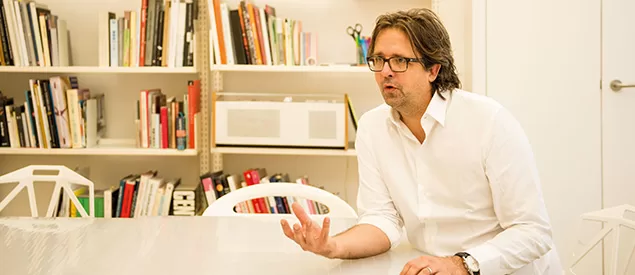 The genial designer, Christoph Behling, London-based by choice, was born in 1970 in Switzerland, grew up in Düsseldorf and went to art school in Stuttgart, where he was an “apprentice“ of Richard Sapper. In 2004 he established the Christoph Behling Design Studio and SolarLab Research & Design. Since 2006 he has been designing bathroom products for the sanitary specialist, Geberit. At LivingInteriors 2016 in Cologne, the Swiss company will present the result of a four-year-long development project: the Mera shower toilet.
The genial designer, Christoph Behling, London-based by choice, was born in 1970 in Switzerland, grew up in Düsseldorf and went to art school in Stuttgart, where he was an “apprentice“ of Richard Sapper. In 2004 he established the Christoph Behling Design Studio and SolarLab Research & Design. Since 2006 he has been designing bathroom products for the sanitary specialist, Geberit. At LivingInteriors 2016 in Cologne, the Swiss company will present the result of a four-year-long development project: the Mera shower toilet.
How is the cooperation with Geberit progressing?
It began with the toilet flush plate. At the time, Geberit just had the standard white flush plate. My suggestion was quite mundane: Most bathrooms are a combination of white and chrome. I wanted to make something elegant with the flush plate, something which really matches the environment which we are creating – the world of bathroom fittings and the world of amazing design. And suddenly this whole segment became very successful for Geberit because from the moment the stylish chrome plate came to market, no one wanted the all-white plate any more. As a result, this small part of the market completely changed, as did the competitors.
To many your long-term relationship with Geberit certainly seems to represent a break with your old glamorous yachting image. What keeps you in the sanitary sector?
It isn’t so much about the relationship with the sector, more with the customers. For me, the thing just clicked immediately. There was one of the largest firms in the sanitary sector but no one really knows them, even though they are three times larger than other, better-known brands. My experience was one of a deeply modest company. Sometimes companies develop their corporate ethics from their own moral standards and Geberit have standards which clearly lift them above other companies. They want to always be perfect and the notion of longevity has high significance for them. Geberit grants a 20-year replacement guarantee. That alone changes the whole company image, because it means that anyone working on a new product is aiming to ensure that it will last for at least twenty years. Ultimately, no one wants an enormous spare parts depot. After all, no one wants an enormous spare parts depot. That also commits the designers, because it would be catastrophic for them to see their product consigned to the waste paper bin on account of the designer’s narcissism. They don’t talk about it much at Geberit, but many of their products are ecologically really fantastic.
One of your latest products is a shower toilet. Is that really significant?
Obviously, a shower toilet is rather unsexy as a product. But that’s precisely why I like it. I begged for the shower toilet. I spent a long time in Japan and had a shower toilet. And I still believe that anyone who has had one in their home for one or two months, would hate to give it up, because without it you feel dirty. You would probably not leave the house in the morning without having showered. This is exactly the feeling you develop with a shower toilet. It is a sort of unfavoured child – no one loves it and people don’t want to talk about it. But it’s my job as a designer to see that my enthusiasm for the subject is reflected in the product and that people come to terms with it.
And what can designers contribute to such a technically complex product?
As a designer, I’m not only responsible for the look, but also work on the ergonomics of a product with the Geberit team. For example: it’s annoying if the toilet is so loud that it wakes up other members of the family. Apart from that, as the designer, I want to develop an ecological toilet, one which works using little water. Anyone can make a toilet which cleans brilliantly, but is loud in the process and uses lots of water. Of course, toilets can also be constructed which get by with little water and flush quietly – but which probably don’t clean particularly well. Both variants exist in one form or another. Mera however is uncompromising. It rinses more thoroughly and at the same time is quieter and even uses less water.
Source: Koelnmesse, republished with permission.
For more information visit http://www.trendletter.info/en/imm-cologne/interior-design-contract-business/







































